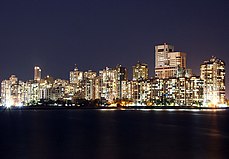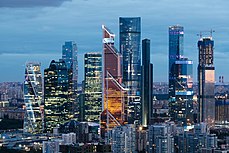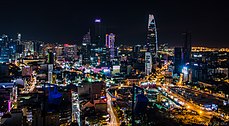
Back Verstedeliking Afrikaans تحضر Arabic Urbanizasiya Azerbaijani Урбанизация Bashkir Урбанізацыя Byelorussian Урбанизация Bulgarian নগরায়ন Bengali/Bangla Kêriekadur Breton Urbanizacija BS Urbanització Catalan

Urbanization (or urbanisation in British English) is the population shift from rural to urban areas, the corresponding decrease in the proportion of people living in rural areas, and the ways in which societies adapt to this change. It can also mean population growth in urban areas instead of rural ones.[1] It is predominantly the process by which towns and cities are formed and become larger as more people begin living and working in central areas.[2]
Although the two concepts are sometimes used interchangeably, urbanization should be distinguished from urban growth. Urbanization refers to the proportion of the total national population living in areas classified as urban, whereas urban growth strictly refers to the absolute number of people living in those areas.[3] It is predicted that by 2050 about 64% of the developing world and 86% of the developed world will be urbanized. This is predicted to generate artificial scarcities of land, lack of drinking water, playgrounds and so on for most urban dwellers.[4] The predicted urban population growth is equivalent to approximately 3 billion urbanites by 2050, much of which will occur in Africa and Asia.[5] Notably, the United Nations has also recently projected that nearly all global population growth from 2017 to 2030 will be by cities, with about 1.1 billion new urbanites over the next 10 years.[6] In the long term, urbanization is expected to significantly impact the quality of life in negative ways.[7][8]
Urbanization is relevant to a range of disciplines, including urban planning, geography, sociology, architecture, economics, education, statistics and public health. The phenomenon has been closely linked to globalization, modernization, industrialization, marketization, administrative/institutional power. and the sociological process of rationalization.[9][10] Urbanization can be seen as a specific condition at a set time (e.g. the proportion of total population or area in cities or towns), or as an increase in that condition over time. Therefore, urbanization can be quantified either in terms of the level of urban development relative to the overall population, or as the rate at which the urban proportion of the population is increasing. Urbanization creates enormous social, economic and environmental challenges, which provide an opportunity for sustainability with the "potential to use resources much less or more efficiently, to create more sustainable land use and to protect the biodiversity of natural ecosystems." However, current urbanization trends have shown that massive urbanization has led to unsustainable ways of living.[5] Developing urban resilience and urban sustainability in the face of increased urbanization is at the center of international policy in Sustainable Development Goal 11 "Sustainable cities and communities."
Urbanization is not merely a modern phenomenon, but a rapid and historic transformation of human social roots on a global scale, whereby predominantly rural culture is being rapidly replaced by predominantly urban culture. The first major change in settlement patterns was the accumulation of hunter-gatherers into villages many thousands of years ago. Village culture is characterized by common bloodlines, intimate relationships, and communal behaviour, whereas urban culture is characterized by distant bloodlines, unfamiliar relations, and competitive behaviour. This unprecedented movement of people is forecast to continue and intensify during the next few decades, mushrooming cities to sizes unthinkable only a century ago. As a result, the world urban population growth curve has up till recently followed a quadratic-hyperbolic pattern.[11]
- ^ "Urbanization". MeSH browser. National Library of Medicine. Archived from the original on 16 March 2016. Retrieved 5 November 2014.
The process whereby a society changes from a rural to an urban way of life. It refers also to the gradual increase in the proportion of people living in urban areas.
- ^ "Urbanization in". demographic partitions. Archived from the original on 22 October 2018. Retrieved 8 July 2015.
- ^ Tacoli, Cecilia (2015). Urbanisation, rural-urban migration and urban poverty. McGranahan, Gordon, Satterthwaite, David. London: International Institute for Environment and Development. ISBN 9781784311377. OCLC 942419887.
- ^ "Urban life: Open-air computers". The Economist. 27 October 2012. Archived from the original on 5 September 2017. Retrieved 20 March 2013.
- ^ a b "Urbanization". UNFPA – United Nations Population Fund. Archived from the original on 26 May 2020. Retrieved 11 May 2015.
- ^ Barney Cohen (2015). "Urbanization, City Growth, and the New United Nations Development Agenda". Vol. 3, no. 2. Cornerstone, The Official Journal of the World Coal Industry. pp. 4–7. Archived from the original on 27 June 2015. Retrieved 26 June 2015.
- ^ Dutt, A.K.; Noble, A.G.; Venugopal, G.; Subbiah, S. (2006). Challenges to Asian Urbanization in the 21st Century. GeoJournal Library. Springer Netherlands. ISBN 978-1-4020-2531-0. Retrieved 22 March 2023.
- ^ Sridhar, K.S.; Mavrotas, G. (2021). Urbanization in the Global South: Perspectives and Challenges. Taylor & Francis. ISBN 978-1-000-42636-6. Retrieved 22 March 2023.
- ^ Gries, T.; Grundmann, R. (2018). "Fertility and modernization: the role of urbanization in developing countries". Journal of International Development. 30 (3): 493–506. doi:10.1002/jid.3104.
- ^ Gu, Chaolin (2019). "Urbanization: Processes and driving forces". Science China Earth Sciences. 62 (9): 1351–1360. Bibcode:2019ScChD..62.1351G. doi:10.1007/s11430-018-9359-y.
- ^ Introduction to Social Macrodynamics: Secular Cycles and Millennial Trends. Archived 18 September 2018 at the Wayback Machine Moscow: URSS, 2006; Korotayev A. The World System urbanization dynamics. History & Mathematics: Historical Dynamics and Development of Complex Societies Archived 29 February 2020 at the Wayback Machine. Edited by Peter Turchin, Leonid Grinin, Andrey Korotayev, and Victor C. de Munck. Moscow: KomKniga, 2006. The World System urbanization dynamics. History & Mathematics: Historical Dynamics and Development of Complex Societies Archived 29 February 2020 at the Wayback Machine. Edited by Peter Turchin, Leonid Grinin, Andrey Korotayev, and Victor C. de Munck. Moscow: KomKniga, 2006. ISBN 5-484-01002-0. P. 44-62
© MMXXIII Rich X Search. We shall prevail. All rights reserved. Rich X Search



